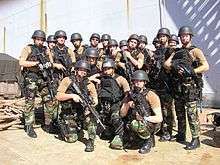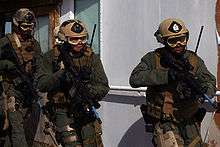Visit, board, search, and seizure

_keep_watch_over_the_crew_of_a_suspected_pirate_dhow.jpg)

Visit, board, search, and seizure (VBSS) is the term used by military and law enforcement agencies for maritime boarding actions and tactics, designed to capture enemy vessels, to combat terrorism, piracy and smuggling, and to conduct customs, safety and other inspections, as employed by modern navies, marine and maritime services, military and police forces.
United States Navy training
Training begins with SRF-B (Security Reaction Force Basic), and continues with SRF-A (Security Reaction Force Advanced), which includes the application of OC spray (Oleoresin Capsicum, pepper spray) on the trainee. After both SRF-B and SRF-A are successfully completed, a candidate qualifies for VBSS school.
The initial training continuum includes three courses, lasting a total of eight weeks (SRF-A, SRF-B, VBSS), with some team members receiving additional follow-on training. Skills taught in VBSS training revolve around Close Quarters Battle (CQB). Training consists of proficiency in tactical movements and shooting, hand-to-hand offensive and defensive combat tactics, rappelling, searching, non-compliant combatant detention, and several other combat kinetic team and personal skills. Some units, known as Helicopter Visit, Board, Search, and Seizure (HVBSS) teams, have been trained to fast rope aboard vessels from helicopters.
All sailors in the U.S. Navy are eligible to serve aboard a VBSS team, but those who aspire to join a team have to be approved by their ship's command. Being approved does not guarantee inclusion on a VBSS team, as it is possible (and not uncommon) for candidates to wash out of VBSS school. The attrition rate for VBSS is 25-30%, on average.
U.S. Navy VBSS teams are generally armed with Mk 18 or M4 carbines as well as Mossberg 500 shotguns and Beretta M9 pistols. The body armor is generally of the Kevlar law enforcement type with ballistic plate inserts and a buoyant tactical vest that doubles as a life preserver. The majority of U.S. naval ships deploying with VBSS teams are smaller, such as destroyers, cruisers, etc. VBSS teams are used to combat illegal narcotics, arms trafficking and piracy.
United States Marine Corps

The United States Marine Corps has several units that conduct VBSS. The premier VBSS force is the ARG/MEU's Maritime Raid Force (MRF), previously known as the Maritime Special Purpose Force. Additionally the various Fleet Antiterrorism Security Teams are trained to varying levels of proficiency in VBSS.
MRF
The MRF is a sub-unit of the ARG/MEU that is task-organized for each specific mission. However, it typically consists of three platoons: a Force Reconnaissance Platoon as the assault element, an Amphibious Reconnaissance Platoon as the support element, and a Battalion Landing Team infantry platoon as the security element. Together these form the backbone of the MRF and are usually augmented by: Explosive Ordnance Disposal technicians, Counter-Intelligence/Human Intelligence, Joint terminal attack controllers, Military information support operators, United States Coast Guard Law Enforcement Detachments, and Chemical, biological, radiological, and nuclear specialists, among others as needed.
The backbone platoons and enablers are then married with the needed support assets for a particular mission, such as USN and USMC aircraft and small boats. Integral to the ARG/MEU construct, and bringing to bear the full range of ARG/MEU capabilities, the MRF is a conventional force that is capable of many 'SOF-like' missions, including opposed VBSS.
United States Coast Guard
_asks_the_captain_of_a_cargo_ship_if_there_is_an_operating_copier_on_board.jpg)
The U.S. Coast Guard is another service that commonly responds to VBSS scenarios. Law enforcement boarding teams from cutters and stations are generally armed with SIG P229 pistols, Remington M870P shotguns, and M16 rifles or currently the M-4 SOPMOD, specifically the MK 18. Additionally, the Coast Guard has a number of specialized units within its Deployable Operations Group that have advanced boarding capabilities.
In addition to law enforcement, the USCG will often use VBSS to conduct at-sea safety inspections of civilian vessels in US waters to ensure they are abiding by applicable safety regulations, have necessary safety equipment on board, and that said equipment is in proper working order.
See also
- Maritime Interdiction Operations (MIO)
- Maritime Security Operations (MSO)
- Military operations other than war (MOOTW)
- MV Magellan Star (Opposed VBSS by 15th MEU MRF)
External links
| Wikimedia Commons has media related to Visit, Board, Search, and Seizure. |
- Everything a Maritime Operator needs Board and Seize
- Marines TV: 31st MEU Force Reconnaissance Marines conduct VBSS exercise Defense Video & Imagery Distribution System
- Marines TV Headlines: VBSS Defense Video & Imagery Distribution System
- (USS) Paul Hamilton Completes Hands-on Search and Seizure Training US Navy
- Vessel Board Search & Seizure (VBSS) Images RIMPAC 2006
- U.S., Canadian Navies Challenge Skills Military.com
- Royal Navy Boarding’s Clamp down on Illegal Activities at Sea VBSS action to clamp down on fuel smuggling.